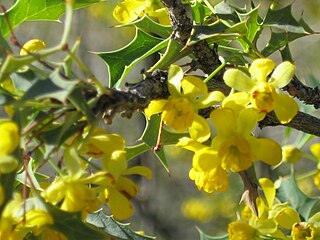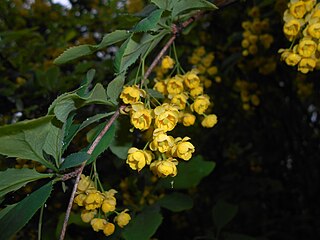
Mahonia is a genus of approximately 70 species of evergreen shrubs and, rarely, small trees in the family Berberidaceae, native to eastern Asia, the Himalaya, North and Central America. They are closely related to the genus Berberis and botanists disagree on whether to recognize a separate Mahonia. Many botanists prefer to classify Mahonia as a part of Berberis because several species in both genera are able to hybridize, and because there are no consistent morphological differences between the two groups other than the leaf pinnation. However, recent DNA-based phylogenetic studies retain the two separate genera, by clarifying that unifoliolate-leaved Berberis s.s. is derived from within a paraphyletic group of shrubs bearing imparipinnate evergreen leaves, which are then divided into three genera: Mahonia, Alloberberis, and Moranothamnus ; a broadly-circumscribed Berberis would also be monophyletic.

Berberis, commonly known as barberry, is a large genus of deciduous and evergreen shrubs from 1–5 m (3.3–16.4 ft) tall, found throughout temperate and subtropical regions of the world. Species diversity is greatest in South America and Asia; Europe, Africa and North America have native species as well. The best-known Berberis species is the European barberry, Berberis vulgaris, which is common in Europe, North Africa, the Middle East, and central Asia, and has been widely introduced in North America. Many of the species have spines on the shoots and all along the margins of the leaves.

The Berberidaceae are a family of 18 genera of flowering plants commonly called the barberry family. This family is in the order Ranunculales. The family contains about 700 known species, of which the majority are in Berberis. The species include trees, shrubs and perennial herbaceous plants.

Berberis microphylla, common name box-leaved barberry and Magellan barberry, in Spanish calafate and michay and other names, is an evergreen shrub, with simple, shiny box-like leaves. The calafate is native to southern Argentina and Chile and is a symbol of Patagonia.

Berberis thunbergii, the Japanese barberry, Thunberg's barberry, or red barberry, is a species of flowering plant in the barberry family Berberidaceae, native to Japan and eastern Asia, though widely naturalized in China and North America, where it has become a problematic invasive in many places, leading to declines in species diversity, increased tick habitat, and soil changes. Growing to 1 m tall by 2.5 m broad, it is a small deciduous shrub with green leaves turning red in the autumn, brilliant red fruits in autumn and pale yellow flowers in spring.
Berberis nilghiriensis is a species of plant in the family Berberidaceae. It is endemic to the Nilgiris of Tamil Nadu, India.

Berberis aristata, also known as Indian barberry, Mara manjal (மரமஞ்சள்),"chutro" or "sumbal" ortree turmeric, is a shrub belonging to the family Berberidaceae and the genus Berberis. The genus comprises approximately 450-500 species of deciduous evergreen shrubs and is found in the temperate and sub-tropical regions of Asia, Europe, and America. B. aristata is native to the Himalayas in India and in Nepal. It is also naturally found in the Nilgiri Mountains of southern India and in Sri Lanka.

Berberis valdiviana is a species of flowering plant in the barberry family Berberidaceae. It is an evergreen shrub from Chile, where it is locally known as cien or espina en cruz. The Latin specific name valdiviana refers to the Valdivia Province of Chile. It has simple, dark green, pointed leaves, glossy on the upper surfaces, up to 8.5 cm (3.3 in) long. The flowers, which appear in May, are grouped in hanging racemes. Individual flowers are orange, 5–8 mm (0.2–0.3 in) across, and are followed by purplish fruits. It is grown as an ornamental plant, but is not suitable for colder regions.
Berberis pimana is a species of the genus Berberis in the family Berberidaceae. It is native to a mountainous region of the Sierra Madre Occidental in the Mexican states of Chihuahua and Sonora.
Berberis moranensis is a shrub in the genus Berberis in the family Berberidaceae. Because of its compound leaves, some botanists place it in the genus Mahonia. It is native to forested regions of the mountains of Mexico from Sinaloa and Guanajuato to Oaxaca. Berberis moranensis has thick waxy leaves, yellow flowers, and purple berries. This species is closely related to Berberis pimanaJ.E. Laferr. & J.S. Marr.
Berberis chochoco is an evergreen shrub or small tree up to 9 m (30 ft) tall, in the genus Berberis, family Berberidaceae. It is native to mountainous regions of northeastern Mexico, in the states of Nuevo León, Veracruz, and San Luis Potosí.

Berberis harrisoniana is a rare species of flowering plant in the barberry family, Berberidaceae. It is known by the common names Kofa barberry, Kofa Mountain barberry, Harrison's barberry, and red barberry.

Berberis haematocarpa, Woot. with the common names red barberry, red Mexican barbery, Colorado barberry and Mexican barberry, is a species in the Barberry family in southwestern North America. It is also sometimes called algerita, but that name is more often applied to its relative, Mahonia trifoliolata.
Berberis wilcoxii is a shrub native to Arizona, New Mexico and Sonora. It is up to 2 m tall, with pinnately compound leaves of 5-7 leaflets, densely clustered racemes and ovoid berries up to 10 mm long. It is generally found in rocky canyons in mountainous areas at an elevation of 1700–2500 m.
Berberis muelleri is a shrub with compound leaves, native to the Mexican State of Nuevo León.
Berberis lanceolata is a shrub in the Berberidaceae described as a species in 1840. It is endemic to Mexico, found in the States of Hidalgo, Oaxaca, Veracruz, and Puebla.
Berberis hartwegii is a shrub in the Berberidaceae described as a species in 1840. It is endemic to Mexico, found in the States of Hidalgo, San Luis Potosí, and Tamaulipas.
Berberis lambertii is a shrub in the family Berberidaceae described as a species in 1921. It is known only from the Chamoli and Pithoragarh districts of Uttarakhand in northern India. The species was long thought to be extinct because it had not been collected in nearly 100 years until living populations were discovered recently.

Berberis lycium, called the Indian lycium, Indian barberry, or boxthorn barberry, is a species of flowering plant in the family Berberidaceae. It is native to mountain slopes of the northwestern part of the Indian Subcontinent. A widespread species, its fruit, called kasmal, is edible and is eaten fresh, cooked, and preserved.








